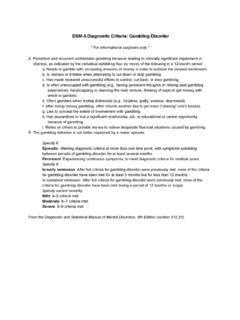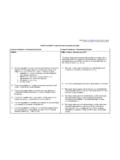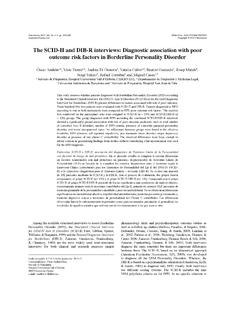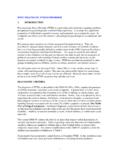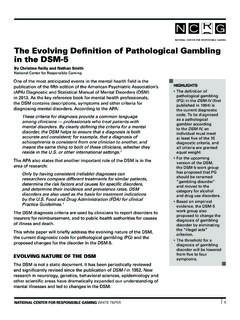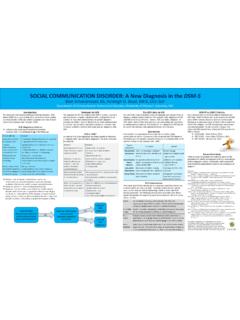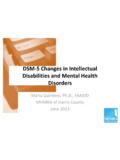Transcription of Obsessive‐Compulsive Disorder in the DSM‐5
1 Obsessive-Compulsive Disorder in theDSM-5 Jonathan S. Abramowitz and Ryan J. Jacoby, Department of Psychology, University of NorthCarolina at Chapel HillWhereas the specific diagnostic criteria for obsessive-compulsive Disorder (OCD) have changed in only minorways in the transition fromDSM-IVtoDSM-5,a moresubstantial change is that OCD is no longer classified asan anxiety Disorder . Rather, it is now the flagshipdiagnosis of a new diagnostic category: the obsessive-compulsive and related disorders (OCRDs). In this arti-cle, we describe the nature of obsessional problems asdetermined through empirical research before turningto a consideration of how OCD is defined in previouseditions of theDSMand inDSM-5.
2 We then criticallyconsider theDSMcriteria, as well as the basis forremoving OCD from the anxiety disorders and creatingthe new OCRD category. Finally, we consider the impli-cations of these changes for clinical practice andresearch on words:behavioral therapy, cognitive therapy,DSM-5, hair pulling, hoarding, nosology, obsessive com-pulsive, obsessive-compulsive Disorder .[Clin Psychol SciPrac 21:221 235, 2014]Obsessional problems, and indeed obsessive-compulsivedisorder (OCD) as defined in theDiagnostic and Statisti-cal Manual of Mental disorders (DSM), involve a com-plex and heterogeneous collection of thoughts,behaviors, and their interplay. While the preciseetiology remains uncertain, the nature and phenome-nology of obsessional problems are well researched andwell understood, and effective psychological andpharmacological treatments exist.
3 The recent transitionfromDSM-IVtoDSM-5has a number of clinical andresearch implications, as several key changes have beenmade concerning OCD. The present article beginswith a description of the nature of obsessional prob-lems not simply theDSMdefinition of OCD, butrather an evidence-based picture of the fundamentalfeatures of this problem and the mechanisms that serveto maintain them. We then transition to a discussion ofOCD as it is defined in previous editions of theDSMand now inDSM-5, before turning a critical eyetoward changes that were made as well as noteworthydiagnostic issues that were not changed in the transi-tion. The article closes with a consideration of theimplications ofDSM-5for clinical practice and researchwhere OCD is NATURE OF OBSESSIONAL PROBLEMSO bsessionsUnwanted and distressing intrusive thoughts oftencalledobsessions are senseless ideas, images, urges,doubts, and ideas that the person experiences as repug-nant, invasive, uncontrollable, guilt-provoking, anddecidedly persistent (Rachman & Hodgson, 1980).
4 Although highly individualized, the general themes ofobsessions usually pertain to contamination, responsibil-ity for causing (or failing to prevent) harm (to oneself orothers), uncertainty, taboo topics such as sex, violence,and blasphemy, and the need for order and content of obsessions is typically incongruent withthe person s belief system and is not the type of thoughtone would expect of him- or herself. In fact, it is typicalfor obsessions to cast a menacing shadow on matters theperson happens to hold most dear ( , a devoutly reli-gious person with recurrent blasphemous images, or aAddress correspondence to Jonathan S. Abramowitz, PhD,Department of Psychology, UNC-Chapel Hill, Campus Box3270 (Davie Hall), Chapel Hill, NC 27599.)
5 E-mail: 2014 American Psychological Association. Published by Wiley Periodicals, Inc., on behalf of the American Psychological rights reserved. For permissions, please email: conscientious person with persistent doubts thathe is responsible for injuring an innocent person). Obses-sions might be triggered by stimuli in the environment( , a religious icon or driving a car) or occur withoutan apparent trigger ( , the impulse to yell a curse wordin a place of worship). Finally, obsessions aresubjectivelyresisted, meaning that they are accompanied by the sensethat they need to be dealt with, neutralized, or alto-gether avoided. The motivation to resist is activated bythe fear that if action is not taken, disastrous conse-quences will likely Resistance to ObsessionsThe most conspicuous type of resistance to obsessionalthoughts iscompulsive ritualizing.
6 Compulsive rituals areperformed deliberately in response to an obsession,usually with the aim of preventing the feared disasterand/or reducing the associated anxiety or distress ( ,hand washing for 30 min after touching a possibly con-taminated doorknob; Rachman & Hodgson, 1980).Common compulsive rituals include washing or clean-ing, checking, or seeking reassurance from others,repeating a routine activity until it feels right, order-ing and arranging items, and performing mental rituals( , saying a phrase or prayer to oneself). Such ritualsare usually senseless and excessive in relation to theobsessional fear, and often need to be performedrepeatedly and according to rules that the personderives on his or her ( , neither rule-bound norrepeated) forms of resistance to obsessions are alsocommon ( , Freeston & Ladouceur, 1997; Ladouc-eur et al.)
7 , 2000). Examples of this sort of resistanceinclude purposely distracting oneself from obsessionalthoughts and triggers, trying to suppress ( , not thinkabout) the unwanted thoughts, and brief (covert) neu-tralization strategies such as gripping the steeringwheel more tightly in response to an obsessionalthought of driving into opposing traffic. The passiveavoidance of obsessional stimuli ( , toilets) is also aform of resistance to obsessions. Avoidance, however,is intended topreventobsessional thoughts and fearedconsequences from occurring in the first place, whereasneutralizing and other forms of resistance representreac-tionsto obsessions that have already occurred (Rach-man & Hodgson, 1980).
8 Clinical observations of individuals with obsessionalproblems reveal an internal consistency in the themesof obsessions and the strategies used to resist suchmental intrusions. Research findings support theseobservations, consistently showing that obsessions andresistance strategies are thematically related ( , Abra-mowitz et al., 2010; McKay et al., 2004): contamina-tion obsessions often co-occur with washing/cleaningrituals; responsibility obsessions with checking and reas-surance-seeking rituals; obsessions about order or exact-ness with arranging rituals; and unacceptable taboo violent, sexual, or blasphemous thoughts with mentalrituals and more covert forms of resistance.
9 Avoidancebehavior can also generally be predicted by the types ofobsessional fears the individual has. For example,someone with obsessional thoughts of harming herchildren is likely to avoid knives and other potentialweapons. These observations underscore the relation-ship between obsessions and the various forms of sub-jective of Obsessional ProblemsAlthough intrusive thoughts are a universal experience,people with clinically severe obsessional problems ( ,OCD) encounter more persistent intrusions that pro-voke more intense anxiety and distress relative to non-sufferers. They also experience more persistent urges toresist their intrusions and expend greater time andenergy engaged in such activities.
10 One explanation forthis is that people with clinically significant obsessionscatastrophically appraise the meaning and significanceof the otherwise harmless intrusions ( , thinking animmoral thought is the same as performing an immoraldeed ), leading to distress, greater preoccupation withthe intrusion, and more intense urges to resist ( ,Salkovskis, 1999). Moreover, the very resistance strate-gies that are deployed in response to intrusions mayparadoxically intensify the intrusion: for example,attempted thought suppression, which leads to anincrease in the thought to be suppressed ( , Abramo-witz, Tolin, & Street, 2001).Other resistance strategies, such as avoidance and rit-uals, maintain obsessional distress by preventing thecorrection of the unrealistic catastrophic appraisalswhen feared outcomes do not occur.


